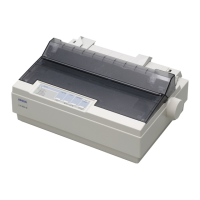
Do you have a question about the Epson LX-300+II RTP and is the answer not in the manual?
| Type | Dot Matrix Printer |
|---|---|
| Interface | USB, Parallel |
| Connectivity | Wired |
| Interfaces | USB, Parallel |
| Buffer | 128 KB |
| Print Method | Impact |
| Print Width | 80 columns |
| Number of Pins | 9 pins |
| Print Resolution | 360 x 360 dpi |
| Resolution | 360 x 360 dpi |
| Paper Handling | Friction feed |
| Paper Path | Front and rear |
| Paper Size | A4, Letter, Custom |
| Paper Width | 101.6 - 254 mm |
| Dimensions | 371 mm x 315 mm x 160 mm |
| Weight | 6.6 lbs (3.0 kg) |
| Operating Systems | Windows, Linux, Mac |
Signals precautions for serious or fatal personal injury if ignored. Exercise great caution.
Signals precautions for damage to equipment if ignored. Exercise great caution.
Overview of the printer's main capabilities, including printing speed, feeding methods, fonts, and interfaces.
Detailed specifications covering print method, speed, resolution, character tables, and hardware characteristics.
Details on parallel, serial, and USB interface protocols, pinouts, timings, and compatibility.
Explanation of printer controls, switches, LEDs, and operational modes in normal and power-on states.
Lists and explanations of ESC/P2 and IBM emulation control codes used for printer commands.
Describes the printer's initialization sequences activated by power-on, cold-reset, or -INIT signal.
Details on supported paper types, sizes, weights, and printable area guidelines for various media.
Dimensions, mass, and appearance details for LX-300+II and LX-1170II models.
Lists of enclosed parts, expendables, and optional accessories available for the printers.
Introduction to the printer's primary components and their electrical circuit board layout.
Detailed explanation of the printer's mechanical components like printhead, carriage, and paper feed.
Explanation of the operation of the main board and power supply circuits, including component functions.
Introduction to troubleshooting methods and flowcharts for identifying and resolving printer issues.
Step-by-step procedures for diagnosing and resolving printer problems based on symptoms and self-checks.
Introduction to the disassembly and assembly process, including essential precautions and recommended tools.
Detailed procedures for disassembling and reassembling various printer components, with check points noted.
Information on the software tool used for printer adjustments, including system requirements and program startup.
Procedures for performing critical printer adjustments like platen gap, Bi-D, and margin settings.
Guidelines for routine cleaning and lubrication of printer parts for optimal performance and longevity.
Specific disassembly and assembly procedures for the LX-300+II RTP variant, following standard procedures.
Adjustment procedures specific to the LX-300+II RTP model using the adjustment program.
Comprehensive list of parts for the LX-300+II RTP, referenced by code, for identification and ordering.
Visual breakdown of printer components for the LX-300+II RTP, aiding parts identification and assembly.
Overview of connectors on the main board and their pin assignments for system connectivity.
Map of EEPROM addresses detailing various printer settings, their values, and factory configurations.
Detailed list of replaceable parts for LX-300+II and LX-1170II, cross-referenced with exploded diagrams.
Visual diagrams illustrating the assembly of printer components for LX-300+II and LX-1170II.
Diagrams illustrating the electrical circuits of the printer's main board, panel, and power supply.